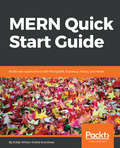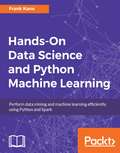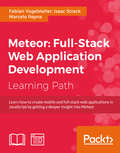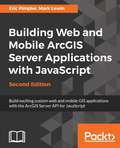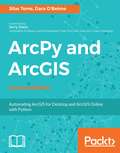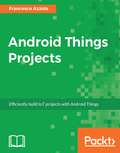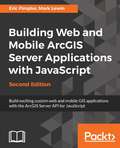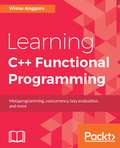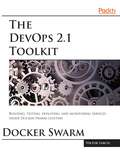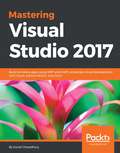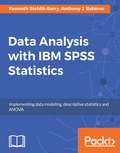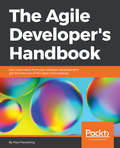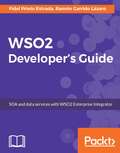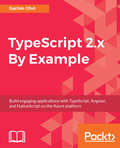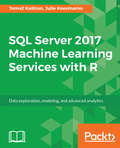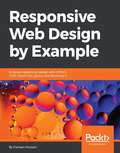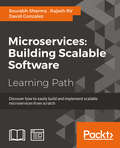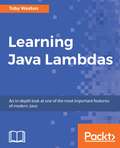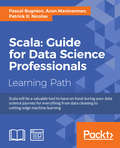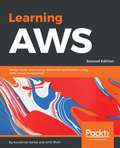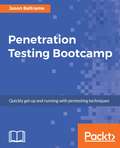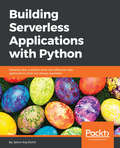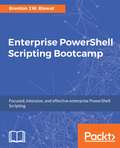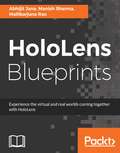- Table View
- List View
MERN Quick Start Guide: Build web applications with MongoDB, Express.js, React, and Node
by Eddy WilsonBuild web applications with MongoDB, ExpressJS, React, and NodeKey FeaturesBuild applications with the MERN stackWork with each component of the MERN stackBecome confident with MERN and ready for more!Book DescriptionThe MERN stack is a collection of great tools—MongoDB, Express.js, React, and Node—that provide a strong base for a developer to build easily maintainable web applications. With each of them a JavaScript or JavaScript-based technology, having a shared programming language means it takes less time to develop web applications. This book focuses on providing key tasks that can help you get started, learn, understand, and build full-stack web applications. It walks you through the process of installing all the requirements and project setup to build client-side React web applications, managing synchronous and asynchronous data flows with Redux, and building real-time web applications with Socket.IO, RESTful APIs, and other concepts. This book gives you practical and clear hands-on experience so you can begin building a full-stack MERN web application.Quick Start Guides are focused, shorter titles that provide a faster paced introduction to a technology. They are for people who don't need all the detail at this point in their learning curve. The presentation has been streamlined to concentrate on the things you really need to know.What you will learnGet started with the MERN stackInstall Node.js and configure MongoDBBuild RESTful APIs with Express.js and MongooseBuild real-time applications with Socket.IO Manage synchronous and asynchronous data flows with ReduxBuild web applications with React Who this book is forThe book is for JavaScript developers who want to get stated with the MERN Stack.
Azure IoT Development Cookbook
by Yatish PatilOver 50 recipes to drive IoT innovation with Microsoft Azure About This Book • Build secure and scalable IoT solutions with Azure IoT platform • Learn techniques to build end to end IoT solutions leveraging the Azure IoT platform • Filled with practical recipes to help you increase connectivity and automation across IoT devices Who This Book Is For If you are an application developer and want to build robust and secure IoT solution for your organization using Azure IoT, then this book is for you. What You Will Learn • Build IoT Solutions using Azure IoT & Services • Learn device configuration and communication protocols • Understand IoT Suite and Pre-configured solutions • Manage Secure Device communications • Understand Device management, alerts • Introduction with IoT Analytics, reference IoT Architectures • Reference Architectures from Industry • Pre-Configured IoT Suite solutions In Detail Microsoft's end-to-end IoT platform is the most complete IoT offering, empowering enterprises to build and realize value from IoT solutions efficiently. It is important to develop robust and reliable solutions for your organization to leverage IoT services. This book focuses on how to start building custom solutions using the IoT hub or the preconfigured solution of Azure IoT suite. As a developer, you will be taught how to connect multiple devices to the Azure IoT hub, develop, manage the IoT hub service and integrate the hub with cloud. We will be covering REST APIs along with HTTP, MQTT and AMQP protocols. It also helps you learn Pre-Configured IoT Suite solution. Moving ahead we will be covering topics like:-Process device-to-cloud messages and cloud-to-device messages using .Net-Direct methods and device management-Query Language, Azure IoT SDK for .Net-Creating and managing, Securing IoT hub, IoT Suite and many more. We will be using windows 10 IoT core, Visual Studio, universal Windows platform. At the end, we will take you through IoT analytics and provide a demo of connecting real device with Azure IoT. Style and approach A set of exciting recipes of using Microsoft Azure IoT more effectively.
Hands-On Data Science and Python Machine Learning
by Frank KaneThis book covers the fundamentals of machine learning with Python in a concise and dynamic manner. It covers data mining and large-scale machine learning using Apache Spark. About This Book • Take your first steps in the world of data science by understanding the tools and techniques of data analysis • Train efficient Machine Learning models in Python using the supervised and unsupervised learning methods • Learn how to use Apache Spark for processing Big Data efficiently Who This Book Is For If you are a budding data scientist or a data analyst who wants to analyze and gain actionable insights from data using Python, this book is for you. Programmers with some experience in Python who want to enter the lucrative world of Data Science will also find this book to be very useful, but you don't need to be an expert Python coder or mathematician to get the most from this book. What You Will Learn • Learn how to clean your data and ready it for analysis • Implement the popular clustering and regression methods in Python • Train efficient machine learning models using decision trees and random forests • Visualize the results of your analysis using Python's Matplotlib library • Use Apache Spark's MLlib package to perform machine learning on large datasets In Detail Join Frank Kane, who worked on Amazon and IMDb's machine learning algorithms, as he guides you on your first steps into the world of data science. Hands-On Data Science and Python Machine Learning gives you the tools that you need to understand and explore the core topics in the field, and the confidence and practice to build and analyze your own machine learning models. With the help of interesting and easy-to-follow practical examples, Frank Kane explains potentially complex topics such as Bayesian methods and K-means clustering in a way that anybody can understand them. Based on Frank's successful data science course, Hands-On Data Science and Python Machine Learning empowers you to conduct data analysis and perform efficient machine learning using Python. Let Frank help you unearth the value in your data using the various data mining and data analysis techniques available in Python, and to develop efficient predictive models to predict future results. You will also learn how to perform large-scale machine learning on Big Data using Apache Spark. The book covers preparing your data for analysis, training machine learning models, and visualizing the final data analysis. Style and approach This comprehensive book is a perfect blend of theory and hands-on code examples in Python which can be used for your reference at any time.
Meteor: Full-Stack Web Application Development
by Marcelo Reyna Isaac Strack Fabian VogelstellerLearn how to create mobile and full-stack web applications in JavaScript by getting a deeper insight into Meteor About This Book * This step-by-step tutorial will show you how to build fast, complex web applications * Over 65 hands-on recipes help you build and deploy elegant web applications * Optimize your web application for production use Who This Book Is For If you are a web developer who is familiar with Meteor and has basic knowledge of web development, and you now want to explore new paradigms of single-page, real-time applications, this course is perfectly suited for you. What You Will Learn * Secure your site with Meteor best practices * Create reactive templates that update themselves when data changes * Add routing to a single-page application and make it appear like a real website * Make your own Meteor packages and see how to make them public * Rapidly build robust, responsive user interfaces * Publish your own reusable custom packages * Optimize your site for load speed with advanced publishers and subscribers * Master the intricacies of front-end development using Jeet, Bootstrap, CSS animations, and more * Leverage the aggregation framework to produce results with big data * Optimize your site for search engine visibility In Detail Meteor is best JavaScript development platform and is packed with collections of libraries and packages bound together in a tidy way to take care of everything from development to production, making your web development easier. This course follows a learning path divided into three modules. Each module is a mini course in its own right, taking your knowledge to a new level as you progress. The first module takes you from the installation of Meteor to building a fully working web blog (including back end) to create and edit posts. Your path will begin with the basic concepts and folder structure of a Meteor project, learning how Meteor templates work to test packages, and seeing the application itself. The second module is a cookbook that starts with simple recipes designed for quick reference, and culminating advanced recipes that walk you through building and deploying a complete application. The cookbook covers all the major areas of Meteor development, including lesser-known and undocumented features too. With all the important concepts covered in the previous modules, the third module will get you equipped with simple solutions to boost your development skills. You'll learn about mapping of real-world data and optimizing it, how to optimize and secure web applications and how to deploy and maintain it without breaking its features. Throughout the module, you will put your skills into practice and build an online shop from scratch. This Learning Path combines some of the best that Packt has to offer in one complete, curated package. It includes content from the following Packt products: * Building Single-page Web Apps with Meteor, Fabian Vogelsteller * Meteor Cookbook, Isaac Strack * Meteor Design Patterns, Marcelo Reyna Style and approach This practical handbook has a step-by-step approach to help you improve your developer skills and efficiently built web applications using Meteor.
Building Web and Mobile ArcGIS Server Applications with JavaScript - Second Edition
by Eric Pimpler Mark LewinMaster the ArcGIS API for JavaScript to build web and mobile applications using this practical guide. About This Book • Develop ArcGIS Server applications with JavaScript, both for traditional web browsers as well as the mobile platform • Make your maps informative with intuitive geographic layers, user interface widgets, and more • Integrate ArcGIS content into your custom applications and perform analytics with the ArcGIS Online Who This Book Is For If you are a web or mobile application developer, who wants to create GIS applications in your respective platform, this book is ideal for you. You will need Java Script programming experience to get the most out of this book. Although designed as an introductory to intermediate level book, it will also be useful for more advanced developers who are new to the topic of developing applications with ArcGIS Server. What You Will Learn • To create an application with the ArcGIS API for JavaScript • Build and display a broad range of different geometry types to represent features on the map • The best way to leverage a feature layer and display related attribute data • The functionality of the wide range of widgets and how to use them effectively • Query data to gain new insights into the information it contains • Work with tasks to discover and locate features on the map • Using the geocoder and associated widgets • The ability of the API to provide turn by turn directions and routing capabilities • How to use the Geometry Engine and Geometry Service tasks for common geoprocessing operations • Integrate content on ArcGIS online and add it to your custom web mapping application In Detail The ArcGIS API for JavaScript enables you to quickly build web and mobile mapping applications that include sophisticated GIS capabilities, yet are easy and intuitive for the user. Aimed at both new and experienced web developers, this practical guide gives you everything you need to get started with the API. After a brief introduction to HTML/CSS/JavaScript, you'll embed maps in a web page, add the tiled, dynamic, and streaming data layers that your users will interact with, and mark up the map with graphics. You will learn how to quickly incorporate a broad range of useful user interface elements and GIS functionality to your application with minimal effort using prebuilt widgets. As the book progresses, you will discover and use the task framework to query layers with spatial and attribute criteria, search for and identify features on the map, geocode addresses, perform network analysis and routing, and add custom geoprocessing operations. Along the way, we cover exciting new features such as the client-side geometry engine, learn how to integrate content from ArcGIS.com, and use your new skills to build mobile web mapping applications. We conclude with a look at version 4 of the ArcGIS API for JavaScript (which is being developed in parallel with version 3.x) and what it means for you as a developer. Style and approach Readers will be taken through a series of exercises that will demonstrate how to efficiently build ArcGIS Server applications for the mobile and web.
ArcPy and ArcGIS - Second Edition
by Silas Toms Dara O'BeirneUse Python modules such as ArcPy, ArcREST and the ArcGIS API for Python to automate the analysis and mapping of geospatial data. About This Book • Perform GIS analysis faster by automating tasks. • Access the spatial data contained within shapefiles and geodatabases and transform between spatial reference systems. • Automate the mapping of geospatial analyses and production of map books. Who This Book Is For If you are a GIS student or professional who needs an understanding of how to use ArcPy to reduce repetitive tasks and perform analysis faster, this book is for you. It is also a valuable book for Python programmers who want to understand how to automate geospatial analyses and implement ArcGIS Online data management. What You Will Learn • Understand how to integrate Python into ArcGIS and make GIS analysis faster and easier. • Create Python script using ArcGIS ModelBuilder. • Learn to use ArcGIS online feature services and the basics of the ArcGIS REST API • Understand the unique Python environment that is new with ArcGIS Pro • Learn about the new ArcGIS Python API and how to use Anaconda and Jupyter with it • Learn to control ArcGIS Enterprise using ArcPy In Detail ArcGIS allows for complex analyses of geographic information. The ArcPy module is used to script these ArcGIS analyses, providing a productive way to perform geo-analyses and automate map production. The second edition of the book focuses on new Python tools, such as the ArcGIS API for Python. Using Python, this book will guide you from basic Python scripting to advanced ArcPy script tools. This book starts off with setting up your Python environment for ArcGIS automation. Then you will learn how to output maps using ArcPy in MXD and update feature class in a geodatabase using arcpy and ArcGIS Online. Next, you will be introduced to ArcREST library followed by examples on querying, updating and manipulating ArcGIS Online feature services. Further, you will be enabling your scripts in the browser and directly interacting with ArcGIS Online using Jupyter notebook. Finally, you can learn ways to use of ArcPy to control ArcGIS Enterprise and explore topics on deployments, data quality assurances, data updates, version control, and editing safeguards. By the end of the book, you will be equipped with the knowledge required to create automated analysis with administration reducing the time-consuming nature of GIS. Style and approach The book takes a pragmatic approach, showing ways to automate repetitive tasks and utilizing features of ArcPy with ArcGIS Pro and ArcGIS online.
Android Things Projects
by Francesco AzzolaDevelop smart Internet of things projects using Android Things. About This Book • Learn to build promising IoT projects with Android Things • Make the most out of hardware peripherals using standard Android APIs • Build enticing projects on IoT, home automation, and robotics by leveraging Raspberry Pi 3 and Intel Edison Who This Book Is For This book is for Android enthusiasts, hobbyists, IoT experts, and Android developers who want to gain a deeper knowledge of Android Things. The main focus is on implementing IoT projects using Android Things. What You Will Learn • Understand IoT ecosystem and the Android Things role • See the Android Things framework: installation, environment, SDK, and APIs • See how to effectively use sensors (GPIO and I2C Bus) • Integrate Android Things with IoT cloud platforms • Create practical IoT projects using Android Things • Integrate Android Things with other systems using standard IoT protocols • Use Android Things in IoT projects In Detail Android Things makes developing connected embedded devices easy by providing the same Android development tools, best-in-class Android framework, and Google APIs that make developers successful on mobile. With this book, you will be able to take advantage of the new Android framework APIs to securely build projects using low-level components such as sensors, resistors, capacitors, and display controllers. This book will teach you all you need to know about working with Android Things through practical projects based on home automation, robotics, IoT, and so on. We'll teach you to make the most of the Android Things and build enticing projects such as a smart greenhouse that controls the climate and environment automatically. You'll also create an alarm system, integrate Android Things with IoT cloud platforms, and more. By the end of this book, you will know everything about Android Things, and you'll have built some very cool projects using the latest technology that is driving the adoption of IoT. You will also have primed your mindset so that you can use your knowledge for profitable, practical projects. Style and approach This book is packed with fun-filled, end-to-end projects that you will be encouraged to experiment on the Android Things OS.
Building Web and Mobile ArcGIS Server Applications with JavaScript – Second Edition
by Eric Pimpler<P><P>Master the ArcGIS API for JavaScript to build web and mobile applications using this practical guide. <P><P>About This Book <P><P>Develop ArcGIS Server applications with JavaScript, both for traditional web browsers as well as the mobile platform <P><P>Make your maps informative with intuitive geographic layers, user interface widgets, and more <P><P>Integrate ArcGIS content into your custom applications and perform analytics with the ArcGIS Online <P><P>Who This Book Is For <P><P>If you are a web or mobile application developer, who wants to create GIS applications in your respective platform, this book is ideal for you. You will need Java Script programming experience to get the most out of this book. Although designed as an introductory to intermediate level book, it will also be useful for more advanced developers who are new to the topic of developing applications with ArcGIS Server. <P><P>What You Will Learn <P><P>To create an application with the ArcGIS API for JavaScript <P><P>Build and display a broad range of different geometry types to represent features on the map <P><P>The best way to leverage a feature layer and display related attribute data <P><P>The functionality of the wide range of widgets and how to use them effectively <P><P>Query data to gain new insights into the information it contains <P><P>Work with tasks to discover and locate features on the map <P><P>Using the geocoder and associated widgets <P><P>The ability of the API to provide turn by turn directions and routing capabilities <P><P>How to use the Geometry Engine and Geometry Service tasks for common geoprocessing operations <P><P>Integrate content on ArcGIS online and add it to your custom web mapping application <P><P>In Detail <P><P>The ArcGIS API for JavaScript enables you to quickly build web and mobile mapping applications that include sophisticated GIS capabilities, yet are easy and intuitive for the user. <P><P>Aimed at both new and experienced web developers, this practical guide gives you everything you need to get started with the API. After a brief introduction to HTML/CSS/JavaScript, you'll embed maps in a web page, add the tiled, dynamic, and streaming data layers that your users will interact with, and mark up the map with graphics. You will learn how to quickly incorporate a broad range of useful user interface elements and GIS functionality to your application with minimal effort using prebuilt widgets. As the book progresses, you will discover and use the task framework to query layers with spatial and attribute criteria, search for and identify features on the map, geocode addresses, perform network analysis and routing, and add custom geoprocessing operations. Along the way, we cover exciting new features such as the client-side geometry engine, learn how to integrate content from ArcGIS.com, and use your new skills to build mobile web mapping applications. <P><P>We conclude with a look at version 4 of the ArcGIS API for JavaScript (which is being developed in parallel with version 3.x) and what it means for you as a developer. <P><P>Style and approach <P><P>Readers will be taken through a series of exercises that will demonstrate how to efficiently build ArcGIS Server applications for the mobile and web.
Learning C++ Functional Programming
by Wisnu AnggoroApply Functional Programming techniques to C++ to build highly modular, testable, and reusable code About This Book • Modularize your applications and make them highly reusable and testable • Get familiar with complex concepts such as metaprogramming, concurrency, and immutability • A highly practical guide to building functional code in C++ filled with lots of examples and real-world use cases Who This Book Is For This book is for C++ developers comfortable with OOP who are interested in learning how to apply the functional paradigm to create robust and testable apps. What You Will Learn • Get to know the difference between imperative and functional approaches • See the use of first-class functions and pure functions in a functional style • Discover various techniques to apply immutable state to avoid side effects • Design a recursive algorithm effectively • Create faster programs using lazy evaluation • Structure code using design patterns to make the design process easier • Use concurrency techniques to develop responsive software • Learn how to use the C++ Standard Template Library and metaprogramming in a functional way to improve code optimization In Detail Functional programming allows developers to divide programs into smaller, reusable components that ease the creation, testing, and maintenance of software as a whole. Combined with the power of C++, you can develop robust and scalable applications that fulfill modern day software requirements. This book will help you discover all the C++ 17 features that can be applied to build software in a functional way. The book is divided into three modules—the first introduces the fundamentals of functional programming and how it is supported by modern C++. The second module explains how to efficiently implement C++ features such as pure functions and immutable states to build robust applications. The last module describes how to achieve concurrency and apply design patterns to enhance your application's performance. Here, you will also learn to optimize code using metaprogramming in a functional way. By the end of the book, you will be familiar with the functional approach of programming and will be able to use these techniques on a daily basis. Style and approach This book uses a module-based approach, where each module will cover important aspects of functional programming in C++ and will help you develop efficient and robust applications through gaining a practical understanding.
The DevOps 2.1 Toolkit: Docker Swarm
by Viktor FarcicViktor Farcic's latest book, The DevOps 2.1 Toolkit: Docker Swarm, shows you how to successfully integrate Docker Swarm into your DevOps toolset. About This Book • Expand your DevOps Toolkit with the DevOps thought leader, Viktor Farcic • Build, test, deploy, and monitor services inside Docker Swarm clusters • Translate your understanding to different hosting providers like AWS, Azure, and DigitalOcean • Go beyond simple deployment to explore how to create a continuous deployment process • Extend the deep understanding you gained from Viktor's DevOps 2.0 Toolkit book Who This Book Is For This book is for professionals interested in the full microservices life cycle combined with continuous deployment and containers. Target audience could be architects who want to know how to design their systems around microservices. It could be DevOps wanting to know how to apply modern configuration management practices and continuously deploy applications packed in containers. It is for developers who would like to take the process back into their hands as well as for managers who would like to gain a better understanding of the process used to deliver software from the beginning to the end. This book is for everyone wanting to know more about the software development life cycle starting from requirements and design, through the development and testing all the way until deployment and post-deployment phases. We'll create the processes taking into account the best practices developed by and for some of the biggest companies. What You Will Learn • Learn all aspects of Docker Swarm from building, testing, deploying, and monitoring services inside Docker Swarm clusters, available since Docker 1.12. • Master the deeper logic of DevOps with Viktor, so that you can successfully apply that logic across any specific set of tools you're working with. • Translate a deep understanding to different hosting providers like AWS, Azure, DigitalOcean, among others. • You'll go beyond simple deployment: you will explore with Viktor how to create a continuous deployment process. Accomplish zero-downtime deployments, and what to do in case of a failover. • Know how to run services at scale, how to monitor the systems, and how to make it heal itself. In Detail Viktor Farcic's latest book, The DevOps 2.1 Toolkit: Docker Swarm, takes you deeper into one of the major subjects of his international best seller, The DevOps 2.0 Toolkit, and shows you how to successfully integrate Docker Swarm into your DevOps toolset. Viktor shares with you his expert knowledge in all aspects of building, testing, deploying, and monitoring services inside Docker Swarm clusters. You'll go through all the tools required for running a cluster. You'll travel through the whole process with clusters running locally on a laptop. Once you're confident with that outcome, Viktor shows you how to translate your experience to different hosting providers like AWS, Azure, and DigitalOcean. Viktor has updated his DevOps 2.0 framework in this book to use the latest and greatest features and techniques introduced in Docker. We'll go through many practices and even more tools. While there will be a lot of theory, this is a hands-on book. You won't be able to complete it by reading it on the metro on your way to work. You'll have to read this book while in front of the computer and get your hands dirty. Style and approach We'll go through many practices and even more tools. While there will be a lot of theory, this is a hands-on book. You'll have to read this book while in front of the computer and get your hands dirty. The goal is not to master one particular set of tools, but to learn the logic behind them so that you can apply it to your job in various contexts.
Mastering Visual Studio 2017
by Kunal ChowdhuryA guide to mastering Visual Studio 2017 About This Book • Focus on coding with the new, improved, and powerful tools of VS 2017 • Master improved debugging and unit testing support capabilities • Accelerate cloud development with the built-in Azure tools Who This Book Is For .NET Developers who would like to master the new features of VS 2017, and would like to delve into newer areas such as cloud computing, would benefit from this book. Basic knowledge of previous versions of Visual Studio is assumed. What You Will Learn • Learn what's new in the Visual Studio 2017 IDE, C# 7.0, and how it will help developers to improve their productivity • Learn the workloads and components of the new installation wizard and how to use the online and offline installer • Build stunning Windows apps using Windows Presentation Foundation (WPF) and Universal Windows Platform (UWP) tools • Get familiar with .NET Core and learn how to build apps targeting this new framework • Explore everything about NuGet packages • Debug and test your applications using Visual Studio 2017 • Accelerate cloud development with Microsoft Azure • Integrate Visual Studio with most popular source control repositories, such as TFS and GitHub In Detail Visual Studio 2017 is the all-new IDE released by Microsoft for developers, targeting Microsoft and other platforms to build stunning Windows and web apps. Learning how to effectively use this technology can enhance your productivity while simplifying your most common tasks, allowing you more time to focus on your project. With this book, you will learn not only what VS2017 offers, but also what it takes to put it to work for your projects. Visual Studio 2017 is packed with improvements that increase productivity, and this book will get you started with the new features introduced in Visual Studio 2017 IDE and C# 7.0. Next, you will learn to use XAML tools to build classic WPF apps, and UWP tools to build apps targeting Windows 10. Later, you will learn about .NET Core and then explore NuGet, the package manager for the Microsoft development platform. Then, you will familiarize yourself with the debugging and live unit testing techniques that comes with the IDE. Finally, you'll adapt Microsoft's implementation of cloud computing with Azure, and the Visual Studio integration with Source Control repositories. Style and approach This comprehensive guide covers the advanced features of Visual Studio 2017, and communicates them through a practical approach to explore the underlying concepts of how, when, and why to use it.
Data Analysis with IBM SPSS Statistics
by Kenneth Stehlik-Barry Anthony J. BabinecMaster data management & analysis techniques with IBM SPSS Statistics 24 About This Book • Leverage the power of IBM SPSS Statistics to perform efficient statistical analysis of your data • Choose the right statistical technique to analyze different types of data and build efficient models from your data with ease • Overcome any hurdle that you might come across while learning the different SPSS Statistics concepts with clear instructions, tips and tricks Who This Book Is For This book is designed for analysts and researchers who need to work with data to discover meaningful patterns but do not have the time (or inclination) to become programmers. We assume a foundational understanding of statistics such as one would learn in a basic course or two on statistical techniques and methods. What You Will Learn • Install and set up SPSS to create a working environment for analytics • Techniques for exploring data visually and statistically, assessing data quality and addressing issues related to missing data • How to import different kinds of data and work with it • Organize data for analytical purposes (create new data elements, sampling, weighting, subsetting, and restructure your data) • Discover basic relationships among data elements (bivariate data patterns, differences in means, correlations) • Explore multivariate relationships • Leverage the offerings to draw accurate insights from your research, and benefit your decision-making In Detail SPSS Statistics is a software package used for logical batched and non-batched statistical analysis. Analytical tools such as SPSS can readily provide even a novice user with an overwhelming amount of information and a broad range of options for analyzing patterns in the data. The journey starts with installing and configuring SPSS Statistics for first use and exploring the data to understand its potential (as well as its limitations). Use the right statistical analysis technique such as regression, classification and more, and analyze your data in the best possible manner. Work with graphs and charts to visualize your findings. With this information in hand, the discovery of patterns within the data can be undertaken. Finally, the high level objective of developing predictive models that can be applied to other situations will be addressed. By the end of this book, you will have a firm understanding of the various statistical analysis techniques offered by SPSS Statistics, and be able to master its use for data analysis with ease. Style and approach Provides a practical orientation to understanding a set of data and examining the key relationships among the data elements. Shows useful visualizations to enhance understanding and interpretation. Outlines a roadmap that focuses the process so decision regarding how to proceed can be made easily.
The Agile Developer's Handbook: Get more value from your software development: get the best out of the Agile methodology
by Paul FlewellingA pragmatic companion guide to your Agile journey Key Features Make your team Agile by implementing industry-standard Agile techniques Assess scope, scale up efficiently Create the correct roles and identify the right candidates for your team Finish your projects faster and stay ahead of the curve Book Description This book will help you overcome the common challenges you’ll face when transforming your working practices from waterfall to Agile. Each chapter builds on the last, starting with easy-to-grasp ways to get going with Agile. Next you’ll see how to choose the right Agile framework for your organization. Moving on, you’ll implement systematic product delivery and measure and report progress with visualization. Then you’ll learn how to create high performing teams, develop people in Agile, manage in Agile, and perform distributed Agile and collaborative governance. At the end of the book, you’ll discover how Agile will help your company progressively deliver software to customers, increase customer satisfaction, and improve the level of efficiency in software development teams. What you will learn Create a solid foundation that gives your team an Agile jumpstart Understand how to select and evolve practices to increase your team’s agility Use experiments to accelerate your team’s understanding Fine-tune your approach by incorporating aspects of Lean and Lean Startup Know how to foster an environment of continuous improvement and learning that will become self-sustainingWho this book is for If you’re a software developer or a project manager with little to no experience of Agile, but you want to efficiently implement it, this is the book for you.
WSO2 Developer's Guide
by Fidel Prieto Estrada Ramon Garrido LazaroWSO2 Made Simple – dive deep into the core concepts of WSO2 to overcome the challenges faced while using the Enterprise Integrator About This Book • Design, create, and publish services in the WSO2 technology • Integrate the WSO2 Enterprise Integrator with other components and servers • Log and test deployed services Who This Book Is For If you are a Java solutions architect or developer and are keen to understand how to build enterprise applications with WSO2, this book is for you. No prior knowledge of WSO2 is expected. What You Will Learn • Configure WSO2 Enterprise Integrator server in a production environment • Create SOAP Proxies and REST APIs • Interact with WSO2 Message Broker • Write services using the new language: Ballerina • Schedule automatic tasks for the services you create • Manage log messages depending on the log level of the system • Integrate with social networks such as Twitter, Facebook, Instagram, and Yammer • Test SOAP Services using the Tryit feature and SoapUI tool • Work with Quality of Services In Detail WSO2 Enterprise Integrator brings together the most powerful servers provided by the WSO2 company for your SOA infrastructure. As an Enterprise Service Bus (ESB), WSO2 Enterprise Integrator provides greater flexibility and agility to meet growing enterprise demands, whereas, as a Data Services Server (DSS), it provides an easy-to-use platform for integrating data stores, creating composite views across different data sources, and hosting data services. Using real-world scenarios, this book helps you build a solid foundation in developing enterprise applications with powerful data integration capabilities using the WSO2 servers. The book gets you started by brushing up your knowledge about SOA architecture and how it can be implemented through WSO2. It will help build your expertise with the core concepts of ESB such as building proxies, sequences, endpoints, and how to work with these in WSO2. Going further, you will also get well-acquainted with DSS data service concepts such as configuring data services, tasks, events, testing, and much more. The book will also cover API management techniques. Along with ESB and DSS, you will also learn about business process servers, the rules server and other components that together provide the control and robustness your enterprise applications will need. With practical use cases, the book covers typical daily scenarios you will come across while using these servers to give you hands-on experience. Style and approach The book is a complete guide and helps you get the right start—from understanding SOA architectures to getting valuable experience with two important integration servers such as ESB and DSS. It will include some real-world practical scenarios to help you master the best practices followed right across the industry and overcome the challenges you're likely to face on a daily basis.
TypeScript 2.x By Example: Build engaging applications with TypeScript, Angular, and NativeScript on the Azure platform
by Sandeep Singh Sachin OhriKey FeaturesBegin with the fundamentals of TypeScript and learn how to write better JavaScript codeBuild three amazing applications throughout the bookLeverage the power of tools such as Angular 2 and NativeScript to build for the web as well as for mobileBook DescriptionThe TypeScript language, compiler, and open source development toolset brings JavaScript development up to the enterprise level. It allows you to use ES5, ES6, and ES7 JavaScript language features today, including classes, interfaces, generics, modules, and more. Its simple typing syntax enables building large, robust applications using object-oriented techniques and industry-standard design principles.This book aims at teaching you how to get up and running with TypeScript development in the most practical way possible. Taking you through two exciting projects built from scratch, you will learn the basics of TypeScript, before progressing to functions, generics, promises, and callbacks. Then, you’ll get to implement object-oriented programming as well as optimize your applications with effective memory management. You’ll also learn to test and secure your applications, before deploying them. Starting with a basic SPA built using Angular, you will progress on to building, maybe, a Chat application or a cool application. You’ll also learn how to use NativeScript to build a cool mobile application. Each of these applications with be explained in detail, allowing you to grasp the concepts fast.By the end of this book, you will have not only built two amazing projects but you will also have the skills necessary to take your development to the next level.What you will learnDesign your first project in Visual StudioLearn about the different data types in TypeScriptCreate web applications in an object-oriented fashion using TypeScriptBuild a Trello application using TypeScript's complex features.Explore the tools available in a web application ecosystem to write unit test casesDeploy web applications to cloud and assign resources to the application
SQL Server 2017 Machine Learning Services with R: Data exploration, modeling, and advanced analytics
by Julie Koesmarno Tomaz KastrunDevelop and run efficient R scripts and predictive models for SQL Server 2017 Key Features Learn how you can combine the power of R and SQL Server 2017 to build efficient, cost-effective data science solutions Leverage the capabilities of R Services to perform advanced analytics—from data exploration to predictive modeling A quick primer with practical examples to help you get up- and- running with SQL Server 2017 Machine Learning Services with R, as part of database solutions with continuous integration / continuous delivery. Book Description R Services was one of the most anticipated features in SQL Server 2016, improved significantly and rebranded as SQL Server 2017 Machine Learning Services. Prior to SQL Server 2016, many developers and data scientists were already using R to connect to SQL Server in siloed environments that left a lot to be desired, in order to do additional data analysis, superseding SSAS Data Mining or additional CLR programming functions. With R integrated within SQL Server 2017, these developers and data scientists can now benefit from its integrated, effective, efficient, and more streamlined analytics environment. This book gives you foundational knowledge and insights to help you understand SQL Server 2017 Machine Learning Services with R. First and foremost, the book provides practical examples on how to implement, use, and understand SQL Server and R integration in corporate environments, and also provides explanations and underlying motivations. It covers installing Machine Learning Services;maintaining, deploying, and managing code;and monitoring your services. Delving more deeply into predictive modeling and the RevoScaleR package, this book also provides insights into operationalizing code and exploring and visualizing data. To complete the journey, this book covers the new features in SQL Server 2017 and how they are compatible with R, amplifying their combined power. What you will learn Get an overview of SQL Server 2017 Machine Learning Services with R Manage SQL Server Machine Learning Services from installation to configuration and maintenance Handle and operationalize R code Explore RevoScaleR R algorithms and create predictive models Deploy, manage, and monitor database solutions with R Extend R with SQL Server 2017 features Explore the power of R for database administratorsWho this book is for This book is for data analysts, data scientists, and database administrators with some or no experience in R but who are eager to easily deliver practical data science solutions in their day-to-day work (or future projects) using SQL Server.
Responsive Web Design by Example
by Frahaan HussainDevelop mobile-first and adaptive websites that provide the best user experience for a wide range of devices About This Book • Rapidly develop and prototype responsive websites by leveraging the power of Bootstrap • Practice performance optimization techniques to make your site lighter and faster • Learn responsive web design and discover how to build mobile-ready websites with ease Who This Book Is For If you are a web developers interested in incorporating responsive web designs in your websites, then this book is for you. Familiarity with HTML5, CSS3, and command lines, though not essential, will help you get the most out of this book. What You Will Learn • Understand what responsive design is, and why it's vital for modern web development • Customize and extend responsive design frameworks • Create adaptable templates for all future projects • Build a semantic website structure with HTML5 elements • Determine a responsive website persona with CSS3 • Learn how to decide which framework best suits your project specification • Implement a plethora of Bootstrap features in your websites In Detail Desktop-only websites just aren't good enough anymore. As you enter a future of increasingly diverse browsing methods, you need to know how to build websites that are presentable and will work perfectly with the huge volume of different device sizes and resolutions that are now commercially available. Responsive web design is an answer to the problem of modern web development. By following the detailed step-by-step instructions, previews, and examples mentioned in this book, you will learn how to build engaging responsive websites and upgrade your skills as a web designer. With coverage of Responsive Grid System and Bootstrap, you will learn about the most powerful frameworks in responsive web design. In this book, you will learn how to create a crisp blog page, a beautiful portfolio site, a cool social networking page, and a fun photo gallery. Through each of these projects, you'll learn how to build various elements of a modern responsive website, and also find out which framework works best for your project specifications. By the end of the book, you will have gained practical skills you need to build real-world websites that are professional, creative and truly responsive. Style and approach This book conveys the design concepts used to quickly and effectively build responsive websites. We focus less on the theory and more on results, with clear step-by-step instructions, previews, and examples to help you along the way.
Microservices: Building Scalable Software
by Sourabh Sharma Rajesh Rv David GonzalezDiscover how to easily build and implement scalable microservices from scratch About This Book • Build, deploy, and test microservices from scratch with ease • Learn how to efficiently build and implement microservices in Spring, and how to use Docker and Mesos to push the boundaries of what you thought possible • Master the architecture of Mesos and intelligently distribute your task across clusters of machines Who This Book Is For This course is intended for Java and Spring developers, DevOps engineers, and system administrators who are familiar with microservice architecture and have a good understanding of the core elements and microservice applications but now want to delve into effectively implementing microservices at the enterprise level. What You Will Learn • Use a domain-driven approach to design and implement microservices • Secure microservices using Spring Security • Deploy and test microservices • Use Spring Boot to develop microservices • Find out how to avoid common pitfalls when developing microservices • Familiarize yourself with end-to-end microservices written in Spring Framework and Spring Boot • Understand the Mesos architecture • Deploy a multi-node Mesos cluster using your favorite DevOps In Detail Microservices are the next big thing in designing scalable, easy-to-maintain applications, making app development easier and providing great flexibility in utilizing various resources optimally. This course is divided into three modules and each module is a mini-course in its own right, helping you enhance your knowledge. Starting off with the first module, you will understand the core concepts and frameworks of microservice architecture. You will then learn how to set up the development environment and configure it before implementing continuous integration to deploy your microservice architecture. You will learn to secure microservices and test them effectively using REST Java clients and other tools. Finally, you will build smaller, lighter, and faster services that can be implemented easily. The second module will help you implement the microservice architecture in Spring Framework, Spring Boot, and Spring Cloud. With the latest specifications of Spring, you'll be able to build modern, Internet-scale Java applications in no time. You'll delve into Spring Boot, Spring Cloud, Docker, Mesos, and Marathon, and understand how to deploy autonomous services without using heavy-weight application servers. By the end, you'll have a good grasp of Spring Framework and how to implement microservices using it. In the last module of this course, you will learn about Apache Mesos, open source, cluster-management software that provides efficient resource isolations and sharing. This advanced module will show you how to deploy important, big data processing frameworks such as Hadoop, Spark, and Storm on Mesos and big data storage frameworks such as Cassandra, Elasticsearch, and Kafka. This Learning Path combines some of the best that Packt has to offer in one complete, curated package. It includes content from the following Packt products: • Mastering Microservices with Java, Sourabh Sharma • Spring Microservices, Rajesh RV • Mastering Mesos, Dipa Dubhashi Akhil Das Style and approach This course follows a step-by-step approach that teaches readers to build smaller, lighter, and faster services that can be implemented easily in a production environment.
Learning Java Lambdas
by Toby WestonUnderstand and utilize Java Lambdas About This Book • Take a deep dive into one of the single most important additions to modern Java • Master Java lambdas, and fully understand functions, classes, and scope. • Improve your programming skills, which will enable you to write cleaner and more dynamic code Who This Book Is For Learning Java Lambdas is for developers looking to upgrade their Java skills and familiarize themselves with one of the most important new features of Java. This book is not for absolute beginners and will be more suited to professionals who are already comfortable with Java coding. You should have a basic knowledge of Java before reading this book. What You Will Learn • What a lambda is and how it differs from other Java features • How to use lambdas effectively in your own projects • The use of method references and advanced scoping • The difference between lambdas and closures • The differences in bytecode produced when using lambdas In Detail In this short book, we take an in-depth look at lambdas in Java, and their supporting features. The book covers essential topics, such as functional interfaces and type inference, and the key differences between lambdas and closures. You will learn about the background to functional programming and lambdas, before moving on to understanding the basic syntax of lambdas and what differentiates these anonymous functions from standard anonymous classes. Lastly, you'll learn how to invoke lambdas and look at the bytecode generated. After reading this book, you'll understand lambdas in depth, their background, syntax, implementation details, and how and when to use them. You'll also have a clear knowledge of the difference between functions and classes, and why that's relevant to lambdas. This knowledge will enable you to appreciate the improvements to type inference that drive a lot of the new features in modern Java, and will increase your understanding of method references and scoping. Style and approach This book is a deep dive into one of the core new features of the Java language – Lambdas. It covers them in great details, making sure that you fully understand how lambdas work, and how they can be put to use in your own programs.
Scala: Guide for Data Science Professionals
by Patrick R. Nicolas Pascal Bugnion Arun ManivannanScala will be a valuable tool to have on hand during your data science journey for everything from data cleaning to cutting-edge machine learning About This Book • Build data science and data engineering solutions with ease • An in-depth look at each stage of the data analysis process — from reading and collecting data to distributed analytics • Explore a broad variety of data processing, machine learning, and genetic algorithms through diagrams, mathematical formulations, and source code Who This Book Is For This learning path is perfect for those who are comfortable with Scala programming and now want to enter the field of data science. Some knowledge of statistics is expected. What You Will Learn • Transfer and filter tabular data to extract features for machine learning • Read, clean, transform, and write data to both SQL and NoSQL databases • Create Scala web applications that couple with JavaScript libraries such as D3 to create compelling interactive visualizations • Load data from HDFS and HIVE with ease • Run streaming and graph analytics in Spark for exploratory analysis • Bundle and scale up Spark jobs by deploying them into a variety of cluster managers • Build dynamic workflows for scientific computing • Leverage open source libraries to extract patterns from time series • Master probabilistic models for sequential data In Detail Scala is especially good for analyzing large sets of data as the scale of the task doesn't have any significant impact on performance. Scala's powerful functional libraries can interact with databases and build scalable frameworks — resulting in the creation of robust data pipelines. The first module introduces you to Scala libraries to ingest, store, manipulate, process, and visualize data. Using real world examples, you will learn how to design scalable architecture to process and model data — starting from simple concurrency constructs and progressing to actor systems and Apache Spark. After this, you will also learn how to build interactive visualizations with web frameworks. Once you have become familiar with all the tasks involved in data science, you will explore data analytics with Scala in the second module. You'll see how Scala can be used to make sense of data through easy to follow recipes. You will learn about Bokeh bindings for exploratory data analysis and quintessential machine learning with algorithms with Spark ML library. You'll get a sufficient understanding of Spark streaming, machine learning for streaming data, and Spark graphX. Armed with a firm understanding of data analysis, you will be ready to explore the most cutting-edge aspect of data science — machine learning. The final module teaches you the A to Z of machine learning with Scala. You'll explore Scala for dependency injections and implicits, which are used to write machine learning algorithms. You'll also explore machine learning topics such as clustering, dimentionality reduction, Naive Bayes, Regression models, SVMs, neural networks, and more. This learning path combines some of the best that Packt has to offer into one complete, curated package. It includes content from the following Packt products: • Scala for Data Science, Pascal Bugnion • Scala Data Analysis Cookbook, Arun Manivannan • Scala for Machine Learning, Patrick R. Nicolas Style and approach A complete package with all the information necessary to start building useful data engineering and data science solutions straight away. It contains a diverse set of recipes that cover the full spectrum of interesting data analysis tasks and will help you revolutionize your data analysis skills using Scala.
Learning AWS, Second Edition: Design, Build, And Deploy Responsive Applications Using Aws Cloud Components
by Aurobindo SarkarAWS is currently the market leader in the public cloud market.With the increasing global interest in leveraging cloud infrastructure, AWS Cloud from Amazon offers a cutting-edge platform for architecting, building, and deploying web-scale cloud applications. This book will help you in performing these tasks easily.
Penetration Testing Bootcamp
by Jason BeltrameSharpen your pentesting skill in a bootcamp About This Book • Get practical demonstrations with in-depth explanations of complex security-related problems • Familiarize yourself with the most common web vulnerabilities • Get step-by-step guidance on managing testing results and reporting Who This Book Is For This book is for IT security enthusiasts and administrators who want to understand penetration testing quickly. What You Will Learn • Perform different attacks such as MiTM, and bypassing SSL encryption • Crack passwords and wireless network keys with brute-forcing and wordlists • Test web applications for vulnerabilities • Use the Metasploit Framework to launch exploits and write your own Metasploit modules • Recover lost files, investigate successful hacks, and discover hidden data • Write organized and effective penetration testing reports In Detail Penetration Testing Bootcamp delivers practical, learning modules in manageable chunks. Each chapter is delivered in a day, and each day builds your competency in Penetration Testing. This book will begin by taking you through the basics and show you how to set up and maintain the C&C Server. You will also understand how to scan for vulnerabilities and Metasploit, learn how to setup connectivity to a C&C server and maintain that connectivity for your intelligence gathering as well as offsite processing. Using TCPDump filters, you will gain understanding of the sniffing and spoofing traffic. This book will also teach you the importance of clearing up the tracks you leave behind after the penetration test and will show you how to build a report from all the data obtained from the penetration test. In totality, this book will equip you with instructions through rigorous tasks, practical callouts, and assignments to reinforce your understanding of penetration testing. Style and approach This book is delivered in the form of a 10-day boot camp style book. The day-by-day approach will help you get to know everything about penetration testing, from the use of network reconnaissance tools, to the writing of custom zero-day buffer overflow exploits.
Building Serverless Applications with Python: Develop fast, scalable, and cost-effective web applications that are always available
by Jalem Raj RohitBuilding efficient Python applications at minimal cost by adopting serverless architecturesKey Features Design and set up a data flow between cloud services and custom business logic Make your applications efficient and reliable using serverless architecture Build and deploy scalable serverless Python APIsBook DescriptionServerless architectures allow you to build and run applications and services without having to manage the infrastructure. Many companies have adopted this architecture to save cost and improve scalability. This book will help you design serverless architectures for your applications with AWS and Python.The book is divided into three modules. The first module explains the fundamentals of serverless architecture and how AWS lambda functions work. In the next module, you will learn to build, release, and deploy your application to production. You will also learn to log and test your application. In the third module, we will take you through advanced topics such as building a serverless API for your application. You will also learn to troubleshoot and monitor your app and master AWS lambda programming concepts with API references. Moving on, you will also learn how to scale up serverless applications and handle distributed serverless systems in production.By the end of the book, you will be equipped with the knowledge required to build scalable and cost-efficient Python applications with a serverless framework.What you will learn Understand how AWS Lambda and Microsoft Azure Functions work and use them to create an application Explore various triggers and how to select them, based on the problem statement Build deployment packages for Lambda functions Master the finer details about building Lambda functions and versioning Log and monitor serverless applications Learn about security in AWS and Lambda functions Scale up serverless applications to handle huge workloads and serverless distributed systems in production Understand SAM model deployment in AWS LambdaWho this book is forThis book is for Python developers who would like to learn about serverless architecture. Python programming knowledge is assumed.
Enterprise PowerShell Scripting Bootcamp
by Brenton J.W. BlawatThe quick start guide for an advanced enterprise PowerShell framework About This Book • Introduces industry-proven techniques that improve script efficiency and reliability • Example-rich guide based on real-world scenarios • Facilitates building a script that can fully scan a Windows server and identify components Who This Book Is For This book is for IT professionals and Windows administrators who would like to gain intensive, hands-on knowledge and skills on PowerShell without spending hours and hours in learning. If you have been struggling to find the time to gain proficiency and confidence with PowerShell and everyday scripting tasks What You Will Learn • Create an advanced PowerShell scripting template that provides repeatable code to jumpstart all of your scripting projects • Learn how to securely encrypt and store usernames, passwords, and other sensitive data in PowerShell scripts and answer files • Understand how to optimize the performance of scripts to help process large datasets quickly and avoid time-consuming mistakes • Develop a script to scan for non-standard Windows Server configurations and identify service accounts used on Windows Servers • Gather a large list of data from a Windows server without locally or remotely logging in interactively In Detail Enterprise PowerShell Scripting Bootcamp explains how to create your own repeatable PowerShell scripting framework. This framework contains script logging methodologies, answer file interactions, and string encryption and decryption strategies. This book focuses on evaluating individual components to identify the system's function, role, and unique characteristics. To do this, you will leverage built-in CMDlets and Windows Management Instrumentation (WMI) to explore Windows services, Windows processes, Windows features, scheduled tasks, and disk statistics. You will also create custom functions to perform a deep search for specific strings in files and evaluate installed software through executable properties. We will then discuss different scripting techniques to improve the efficiency of scripts. By leveraging several small changes to your code, you can increase the execution performance by over 130%. By the end of this book, you will be able to tie all of the concepts together in a PowerShell-based Windows server scanning script. This discovery script will be able to scan a Windows server to identify a multitude of components. Style and approach This book is all about fast and intensive learning. This means, we don't waste time in helping readers get started. The new content is about leveraging highly-effective examples to build new things, help solving problems in newer and unseen ways, and providing an enterprise-ready platform to create PowerShell Scripts.
HoloLens Blueprints
by Abhijit Jana Mallikarjuna Rao Manish SharmaUnveil the world of mixed reality with HoloLens About This Book • Bring holographic insights to existing line-of-business applications, tools, and workflows • Focus on developing end-to-end realistic holographic application. • Build interactive model scripts and test them in Unity3D and holographic emulators Who This Book Is For This book is targeted at developers and designers working on mixed-reality developments for complex integrated scenarios using HoloLens. What You Will Learn • Interact with holograms using different interaction models • Develop your first holographic app • Integrate holographic applications with cloud systems • Visualize data feeds coming from the cloud through holograms • Manage the application distribution of enterprise-enabled HoloLens • Integrate HoloLens applications with services deployed on Azure • Identify and create 3D Assets and Scenes • Use HoloLens to explore the Internet of Things In Detail Do you want to create stunning applications with HoloLens? Are you a developer who is fascinated with Microsoft HoloLens and its capabilities? If so, this is the book for you. This book introduces and demystifies the HoloLens platform and shows you different ways of interaction with computers (mixed-reality). You will start your mixed-reality journey by understanding different types of digital reality. You will learn to build your first holographic app. Also, you will understand holographic application integration possibilities within Line of Business Applications using Azure. Moving ahead, you will create Integrated Solutions using IoT with HoloLens. Gradually you'll learn how to create and deploy apps on a device. You will learn to publish application to the store; if you are an enterprise developer, you will also manage and distribute applications for enterprise-enabled or domain-joined HoloLens. Finally, you will develop an end-to-end realistic holographic app, ranging from scenario identification to sketching, development, deployment, and, finally, production. Style and approach The book is a project-based guide to help you to create some really astonishing mixed-reality applications. It will provide end-to-end solutions and enable you to build stunning applications for HoloLens.
